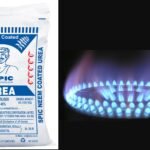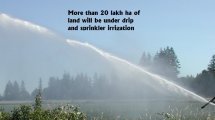Research has supported numerous effective water application strategies, but farmers have their own choice and financial constraints.
In areas where rainfall is scanty and doesn’t come seasonally as expected by the farmers every year or when growing water-demanding crops, farmers are forced to get creative to survive the crops. irrigation is a system of using ground and surface water to directly hydrate the standing crop.
Evapotranspiration by unexpected regular wind and dry sunny weather are issues farmers face when trying to water the field while avoiding waste. accessing water from river and a diminished water table level are also struggles for farmers across many parts of the country. There are multiple ways and methods to irrigate the farming land. Research has supported numerous effective water application strategies, but farmers have their own choice and financial constraints.
They Are Classified As:
Surface Irrigation, Sprinkler Irrigation, and Micro Irrigation.
Surface Irrigation Systems: This system of irrigation is classified as: Flood Irrigation, Border Irrigation, Furrow Irrigation, and Basin Irrigation. The two features that distinguish surface irrigation from other two methods of irrigation are that the free flow of water in response to gravity, and the on-field means of conveyance and distribution is the field surface.
Flood irrigation : Flood irrigation is an uncontrolled water application irrigation system. water from field channels is released in the field whereby little attempt is made to control the flow on the field. this method is often referred to as wild flooding. although these systems are beneficial for their low initial cost and labor requirements, they are non-beneficial for their low efficiency and uniformity flow. this method is mainly used on rolling land where borders, basins, and furrows are not possible and where enough water supply is available.
Border irrigation : This irrigation system is the application of water to slopy, long rectangular lands, and free draining conditions at the lower end of the field. border strips are typically placed in the direction of the greatest slope, are 30 to 65 feet in width and 300 to 1300 feet in length, and have small ridges between the strips to prevent water from overtopping during irrigation. land between borders should be leveled perpendicular to the direction of flow. border irrigation is suitable for most the crops and soil types, but is preferred by slow to moderate intake soils and crops that can tolerate long ponding.
Furrow irrigation : Although the flow of water covers the entire surface area of a field in other surface irrigation methods, irrigation by furrows covers one-fifth to one-half the surface. furrows differ in size and can be placed up and down the slope or on the contour. small, shallow furrows are called corrugations and are typically used for close growing crops such as small grains and alfalfa. larger, deeper furrows are suitable for row crops such as maize.
furrows irrigation system provide best on-farm water management flexibility under many surface irrigation system. the discharge per unit width of the field is considerably reduced and can therefore be adopted on slopes as steep as 12%, if furrows are placed on the contour with the appropriate non-erosive stream size. if furrows are not placed on a contour the maximum advisable slope is 3% or less.
Basin irrigation : Basins are typically rectangular in shape, level in all directions, and are cover by a barrier to prevent runoff. inflow of water into the basins is generally undirected and uncontrolled and can be comparatively efficient if higher rates of flow is available to quickly cover the field. there are few type of crops and soils not conformable to basin irrigation, but it is best suited for moderate to slow intake soil type, deep-rooted, and closely inter spaced crops. exact land leveling is very important to achieving high uniformity and efficiency in all surface irrigation methods.
Sprinkler Irrigation Systems: Sprinkler irrigation is a adoptable method of applying water to any crop, soil, and any topographic condition.
Sprinkler irrigation systems can be economical and efficient on soils and topography that is not suitable or efficient for surface irrigation methods. In general, systems are described according to the method of moving the lateral lines on which different types of sprinklers are connected. Sprinkler systems are extremely efficient but there are common concerns about the intense labor requirements and investment costs for these systems. These systems are only suitable for low-growing crops.
Microirrigation Systems
Microirrigation is a system for delivering slow, frequent applications of water to the soil using a low pressure, low volume distribution method and special flow-control outlets. If managed correctly, microirrigation can enhance yields and reduce water, fertilizer, and labor requirements per acre.
Microirrigation System includes: microsprinklers, drip irrigation, and subsurface drip irrigation.
Microsprinklers, frequently referred to as mini and micro sprayers, typically consist of small emitters placed on short risers above the soil surface. Water is sent through the air, but moves only a short distance before reaching the soil surface. The moister area of emitters in these systems is small, can be controlled easily, and has various shapes to match desired distribution patterns.
Advantages: These systems are the potential for controlling frost, greater adaptability in applying water, and lower susceptibleness to clogging.
Drip irrigation systems deliver water directly to the soil surface or root system and allow water to evaporate under low pressure in a predetermined pattern. These systems are advantageous as water is applied directly to or just above the root zone of the plant, hence reduce water consumption by weeds, while operating at a lower pressure.
The major disadvantages of micro irrigation systems are high initial cost and potential for system blockage, especially the emitters. In some cases, labor inputs may be quite high if rodents burrow and chew system component parts. Correct design, activity and proper maintenance can overcome many of these issues.



















Add Comment